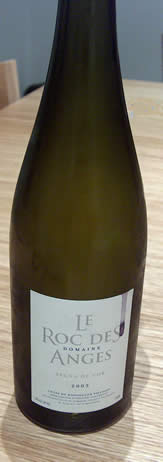|
Extended
Tasting Note No 3
Domaine
Le Roc Des Anges Segna de Cor 2003 CŰtes du Roussillon Villages
 Another
extended tasting note. Iím sharing my own private experience of a
wine, and as a reader of this site pointed out recently, you reading
this note will give you your own separate experience. You canít
share mine, but the better my note is, the more you will have a grasp
of how I found this wine. Another
extended tasting note. Iím sharing my own private experience of a
wine, and as a reader of this site pointed out recently, you reading
this note will give you your own separate experience. You canít
share mine, but the better my note is, the more you will have a grasp
of how I found this wine.
First things first. Appearance. The bottle and label
are striking. Itís a tall bottle with virtually no shoulder, and an
elegant, modern, rather minimalist label. It shouts classy and modern
to the drinker. Prepare for a sophisticated, assured drinking
experience. Expectation is important in wine tasting.
This brings me on to my second point. I donít know
anything about this producer, and very little about the wine. I
suspect it is a varietal Carignan (from memory). Itís CŰtes du
Roussillon Villages, which is quite Ďhappeningí at the moment.
Itís a shame I donít know more, because the context has the
potential to elevate the tasting experience. I always enjoy drinking a
wine more, for example, if I have met the producer.
Open the bottle and pour a glass. Itís quite a dark
red/black colour. The nose initially is dominated by some roast coffee
notes, suggesting a bit of new oak. Underneath that thereís lush,
rich fruit. Probably blackberry is the best descriptor. A little
jammy, but not badly so. Thereís also a savoury spiciness. Itís
ripe and full; not noticeably old world, but not quite new world
either. A bit liqueur like. Trying to tie down smells is difficult,
isnít it? With vision and hearing thereís a spatial and temporal
separation of inputs, respectively. With olfaction, you get everything
at once mixed in together. One smell researcher says it isnít
possible for people to distinguish more than three different aromas in
a mix. Underneath the rich fruit Iím now getting a savoury dimension
dominating.
When I take a sip this is noticeably savoury. Thereís
some firm tannic structure, together with spicy red fruits and some
woodiness. Itís quite a chewy wine. The tannins are mouth drying,
but not overly assertive, and the lushness of the fruit
counterbalances them quite well. Thereís a sort of inkyness to the
wine. You could even say it is minerally.
The context? Iím drinking this on Christmas Eve,
after putting the kids to bed. We have my parents staying, and a
visitor has just popped in, so Iím not totally undistracted. But
Iím drinking from a good glass, with no competing smells, and we
havenít started eating yet.
How good is this wine? You know that I think the
concept of the Ďbestí wine is silly. But I need to make some sort
of quality judgement; Ďqualityí has always to be linked with
purpose, as Iíve argued before. This is a very good, but not great
wine. Itís certainly in a modern style, but thereís still plenty
of southern character to it. Itís quite Ďnew Roussilloní. I
think I paid about £8, which is good value. Iíd serve this with
food: something rich and hearty, maybe a beef daube. If Iím forced
to give a rating, itís not quite 90, but itís closer 90 than 85.
Iíd say 88. Itís probably the overall lack of harmony and slight
protrusion of the alcohol that costs this wine a higher rating. It
doesnít seem quite at peace with itself. But Iím enjoying it,
still.
December
2004
see
other extended tasting notes:
GrŁnhaus;
Veratina; Gaillard
Back to top
|

